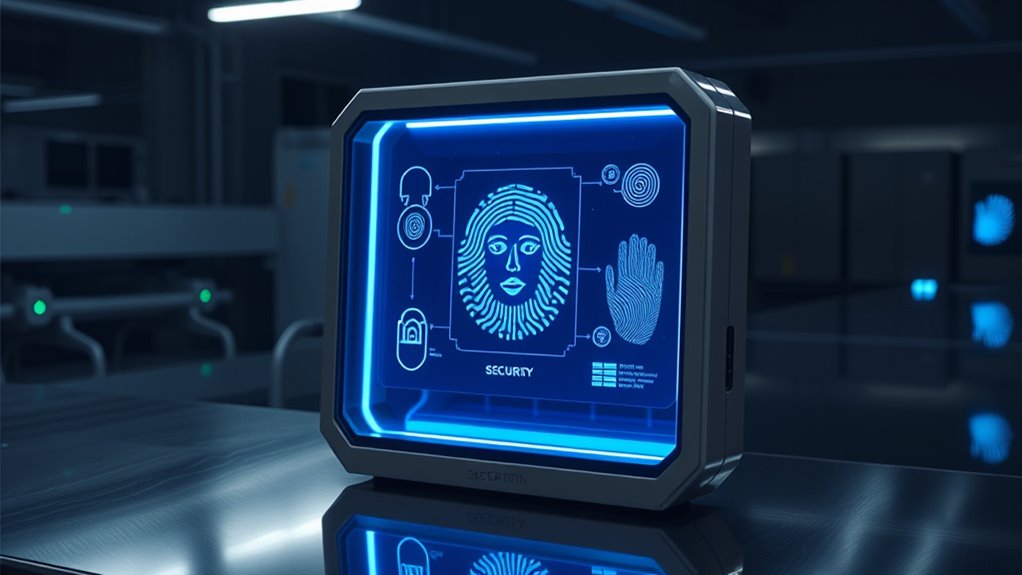Biometric security is moving beyond fingerprints to include voice recognition and facial expression analysis. These methods allow for contactless, real-time identification that’s harder to spoof and works well in dynamic environments. Voice patterns capture unique speech traits, while facial expressions reveal genuine emotional cues, adding extra security layers. If you want to explore how these innovations are shaping the future of authentication, keep going to discover more about these exciting advancements.
Key Takeaways
- Integration of voice recognition allows for hands-free, remote authentication with real-time analysis to prevent spoofing.
- Facial expression analysis adds emotional and microexpression cues for enhanced security and more natural user interactions.
- Multi-modal biometric systems combining voice, facial cues, and behavior improve accuracy and resilience against attacks.
- Behavioral biometrics, including speech patterns and emotional responses, are expanding the scope of secure identification methods.
- Future biometric security emphasizes faster, less intrusive authentication through multi-factor and behavioral biometric integrations.

While fingerprint recognition has long been the standard for biometric security, newer technologies are expanding the possibilities for safer and more versatile authentication methods. Instead of relying solely on physical features, these advanced systems leverage unique behavioral and physiological traits, making security more dynamic and harder to spoof. Voice recognition, for example, is gaining traction as a reliable way to authenticate users, especially in environments where hands-free access is essential. Your voice contains distinct patterns—pitch, tone, speech rhythm—that can be analyzed to verify your identity. Unlike fingerprints, voice recognition can work from a distance, allowing you to access devices or gain secure systems simply by speaking. This technology is becoming increasingly sophisticated, capable of distinguishing between genuine voices and recordings, which substantially enhances security.
Alongside voice-based methods, facial expression analysis is emerging as an innovative biometric tool. While facial recognition scans your facial features—like the distance between your eyes or the shape of your jaw—facial expression analysis adds an extra layer by interpreting your emotional state or natural expressions. This technology recognizes subtle muscle movements and microexpressions that are unique to each person. For instance, a genuine smile or a slight furrow of your brow can be detected and used to confirm your identity. This approach not only bolsters security but also allows for more intuitive interactions with devices, as it can adapt to your emotional cues in real-time. Imagine a secure login that verifies your identity not just through your face, but by evaluating your natural expressions, making unauthorized access even more difficult.
These emerging biometric methods also open doors to more seamless user experiences. Voice recognition can be integrated into smart home systems, allowing you to control everything from lights to locks with just your voice. Similarly, facial expression analysis could enhance security in high-stakes environments, like banking or healthcare, where verifying genuine user intent is critical. Additionally, combining multiple biometric inputs—such as voice and facial expressions—can create a multi-factor authentication system that is both more secure and user-friendly. As these technologies evolve, they’re becoming faster, more accurate, and less intrusive. The key advantage is their ability to combine multiple biometric inputs—voice and facial expressions—creating multi-factor authentication that’s both secure and user-friendly. The future of biometric security isn’t just about fingerprints anymore; it’s about harnessing the richness of human behavior and physiology to protect your digital and physical spaces more effectively.
Frequently Asked Questions
How Secure Are Iris and Retina Scans Compared to Fingerprinting?
Iris and retina scans are more secure than fingerprinting because they rely on unique eye patterns that are harder to replicate. They use advanced cryptographic protocols and data encryption to protect your biometric data, making unauthorized access difficult. While no system is completely foolproof, these scans provide a higher level of security, especially when combined with robust encryption methods, reducing risks like spoofing or hacking.
What Are Emerging Biometric Methods Beyond Facial Recognition?
You’ll find that emerging biometric methods beyond facial recognition include voice authentication and gait analysis. Voice authentication uses your unique vocal patterns for secure access, while gait analysis examines your walking style, which is hard to mimic. These methods enhance security by adding layers of verification, making it tougher for imposters to gain unauthorized access. As technology advances, these biometrics will become more accurate and widely adopted for safer identification.
How Is Biometric Data Protected Against Cyber Threats?
Think of your biometric data as a treasure chest, guarded by digital locks. You can protect it with cryptographic encryption that scrambles your info, making it unreadable to hackers. Biometric anonymization adds a cloak of invisibility, removing identifiable details. Together, these methods fortify your data’s defenses, ensuring that cyber threats can’t break through, keeping your biometric information safe and private.
Can Biometric Systems Be Fooled or Spoofed Easily?
You might wonder if biometric systems can be fooled or spoofed easily. While some attacks are possible, advances in antispoofing techniques markedly improve biometric robustness. Modern systems incorporate liveness detection and multi-factor authentication, making it harder for imposters to deceive them. As technology evolves, these protections become stronger, ensuring your biometric data stays secure and reducing the risk of spoofing attempts.
What Are Privacy Concerns With Advanced Biometric Technologies?
You might think advanced biometric tech is foolproof, but privacy concerns are real. As these systems collect sensitive data, you worry about data ownership—who controls and accesses your info. Consent management becomes tricky, with risks of unauthorized use or breaches. You should stay informed about how your biometric data is stored and used, ensuring your privacy rights are protected and that you’re in control of your personal information.
Conclusion
As technology evolves, your security is like a fortress constantly being reinforced with new, innovative defenses beyond fingerprints. Every step forward adds another layer of armor, making it harder for intruders to breach your digital world. The future of biometric security is a thrilling journey through uncharted territory—where your identity becomes a key only you hold. Stay ahead of the curve, and embrace these advancements as your shield in an ever-changing landscape.









